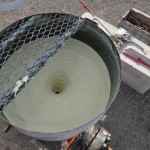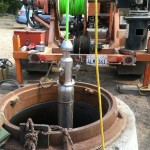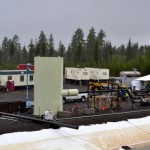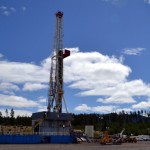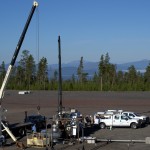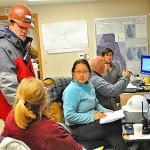
Newberry EGS Demonstration, Oregon
The Newberry EGS Demonstration project is the site of cutting-edge research into enhanced geothermal systems (EGS) development. AltaRock Energy began investigating the Newberry site for EGS development in 2009 . The project site is located on the western flank of Newberry Volcano in Central Oregon and aims to improve the feasibility and viability of EGS technologies and applications. The major goals of the project are to demonstrate current technology and advances in EGS through:
- Stimulation of at least 3 fracture zones
- Successful application of diverter technology for multiple zone stimulation
- Demonstration of single-well test methods to assess productivity after stimulation
- Development of a conceptual model of the completed EGS reservoir
The Newberry Volcano is a large forest-covered shield volcano with a caldera containing two large alpine lakes that are popular recreation destinations. The volcano was identified as a potential site for geothermal energy development several decades ago, and geothermal exploration began in the 1970s. Although geothermal resources were identified inside the caldera, resistance to industrial development led to creation of the Newberry National Volcanic Monument (NNVM) in 1990 and all geothermal leases were moved outside the monument boundary. Stakeholders from industry, government and the public were involved in creation of the Monument, and dedication of NNVM solved critical issues for protecting the scenic and recreational values in the area while providing for continued geothermal research and development outside of the caldera.

Stimulation pumps (blue), piping and equipment on site at the Newberry EGS Demonstration during field work, 2014.
In 2008, Davenport Newberry, LLC., the holder of geothermal leases covering several thousand acres outside NNVM, drilled two 3 km (10,000 ft) deep geothermal wells on the flanks of Newberry. The company hoped to locate and tap into a natural hydrothermal system to produce electricity. Almost two miles below the surface of the volcano, they found very hot rock (315⁰ C, >600⁰ F), but no hydrothermal fluids. The rock here is impermeable, and no water naturally percolates down to the depth of the hot rock; thus, no steam flows out of the deep wells that could be used to turn a turbine.
In 2009, to prepare a proposal to the U.S. Department of Energy, AltaRock evaluated several known geothermal areas with idle hot wells for suitability for an EGS demonstration project. Factoring in geologic and hydrologic assessments, permitting and land use, water rights/access and proximity to population centers, roads, potential transmission line routes, Newberry was chosen as a prime candidate. The two Davenport wells on Newberry Volcano met all of these criteria, and AltaRock formed a partnership with Davenport to use one of their dry geothermal wells for an EGS demonstration project. In 2010, the DOE awarded a matching grant to help fund the Newberry EGS Demonstration proposed by AltaRock. The project is supported by Lawrence Berkeley National Laboratory, University of Utah, Temple University, and scientists from the U.S. Geological Survey and Pacific Northwest Seismic Network.
Since 2010, AltaRock Energy has conducted ongoing research at the site. In 2012, a network of 15 seismometers was deployed at the field site, making Newberry Volcano one of the world’s most well monitored volcanoes. Wellbore surveying activities were completed in 2013, and repairs to well NWG 55-29 were completed in early 2014. An EGS stimulation was conducted using AltaRock’s patented thermally-degradable zonal isolation materials (TZIMs), and microseismic monitoring remains ongoing today.
Future plans for ongoing work at the Newberry EGS Demonstration include drilling a production well which will complete the closed-loop system with the current injection well. Flow and circulation testing will be used to determine productivity of the stimulated EGS reservoir. With good management practices, the geology at this unique site could provide environmentally friendly baseload (24/7) power for decades to come. Ultimately, the Newberry EGS Demonstration site could lead to construction of a 35 MW binary geothermal power plant utilizing a state-of-the-art dry cooling system. A power plant of this size produces roughly enough electricity to power 35,000 homes with clean, renewable energy. The binary system and dry cooling towers are environmentally friendly, generate zero air emissions, and the recirculating reservoir water remains in a closed-loop system at all times.
Newberry Volcano is now home to the Newberry Geothermal Energy (NEWGEN) project, part of the Department of Energy’s Frontier Observatory for Research in Geothermal Energy (FORGE) initiative. The NEWGEN site is being used to improve and develop new geothermal technologies and practices. Click the link above to learn more about the NEWGEN project.
Please visit our Newberry EGS Demonstration blog and the Newberry Geothermal Energy Facebook page for the most up to date information about activities at the project site. Additional photos from this and other project sites can be found in our Media Kit. AltaRock’s Technical Papers page includes a large number of published papers about the project. For information on investment opportunities, please Contact Us.
The Bureau of Land Management (BLM) visited the Newberry EGS Demonstration during the early weeks of field work in 2014 and shot this video overview of the project. Enjoy!
Project Documents
View our Technical Papers from this and other projects here
September 19, 2012
BLM issues Sundry Permit to allow stimulation:
March 15, 2012
View answers to ten frequently asked questions (FAQ) raised during the Environmental Assessment (EA) comment period:
December 23, 2011
View the U.S. Bureau of Land Management (BLM) Environmental Assessment (EA) on their website:
August 10, 2011
View the Department of Energy Written Approval of the Induced Seismicity Mitigation Plan (ISMP):
August 3, 2011
Download the Newberry EGS Demonstration Induced Seismicity Mitigation Plan (ISMP):
February 24, 2011
Kleinfelder Independent Hydrology Review Report – An independent review of AltaRock’s water usage plans for the Newberry EGS Demonstration:
February 11, 2011
View a follow-up to the seismic report, including ground shaking maps and evaluation of other public concerns:
February 9, 2011
Download the Evaluation of Water Usage (Note: 12.4MB Multi-File PDF Package) document for the Newberry EGS Demonstration:
December 17, 2010
Download a poster summary of the EGS Demonstration plan:
November 30, 2010
Download the Seismic Report:
June 9, 2010
Download the Newberry EGS Demonstation Fact Sheet:
June 9, 2010
Download the White Paper for more in depth information about the Newberry EGS Demonstration:
June 8, 2010
Read the Newberry EGS Demonstation Press Release:
June 8, 2010
Notice of Intent – Submitted for review by the BLM, including Plan of Exploration, Operations Plan and Drilling Program



